Leadership in Business: A Report on Organizational Strategy
VerifiedAdded on 2023/01/17
|17
|4124
|52
Report
AI Summary
This report provides a comprehensive analysis of leadership within business organizations, exploring various leadership styles, organizational strategies, and motivational theories. The report begins with a reflective statement on leadership, followed by an examination of fundamental questions, key aspects of leadership, and different leadership approaches. It then delves into organizational mission and vision, the contributions of leaders and stakeholders, and the evaluation of these contributions. The report further analyzes leadership strategies, change leadership, and organizational potential within the business context. Motivational theories are discussed, including content and process theories, along with a critical evaluation of their application. The report also includes a management report that focuses on servant leadership, a critical evaluation of Kevin Johnson's leadership style, his personal brand, and recommendations for leadership improvement. The report provides insights into leading business organizations and offers practical strategies for effective leadership.
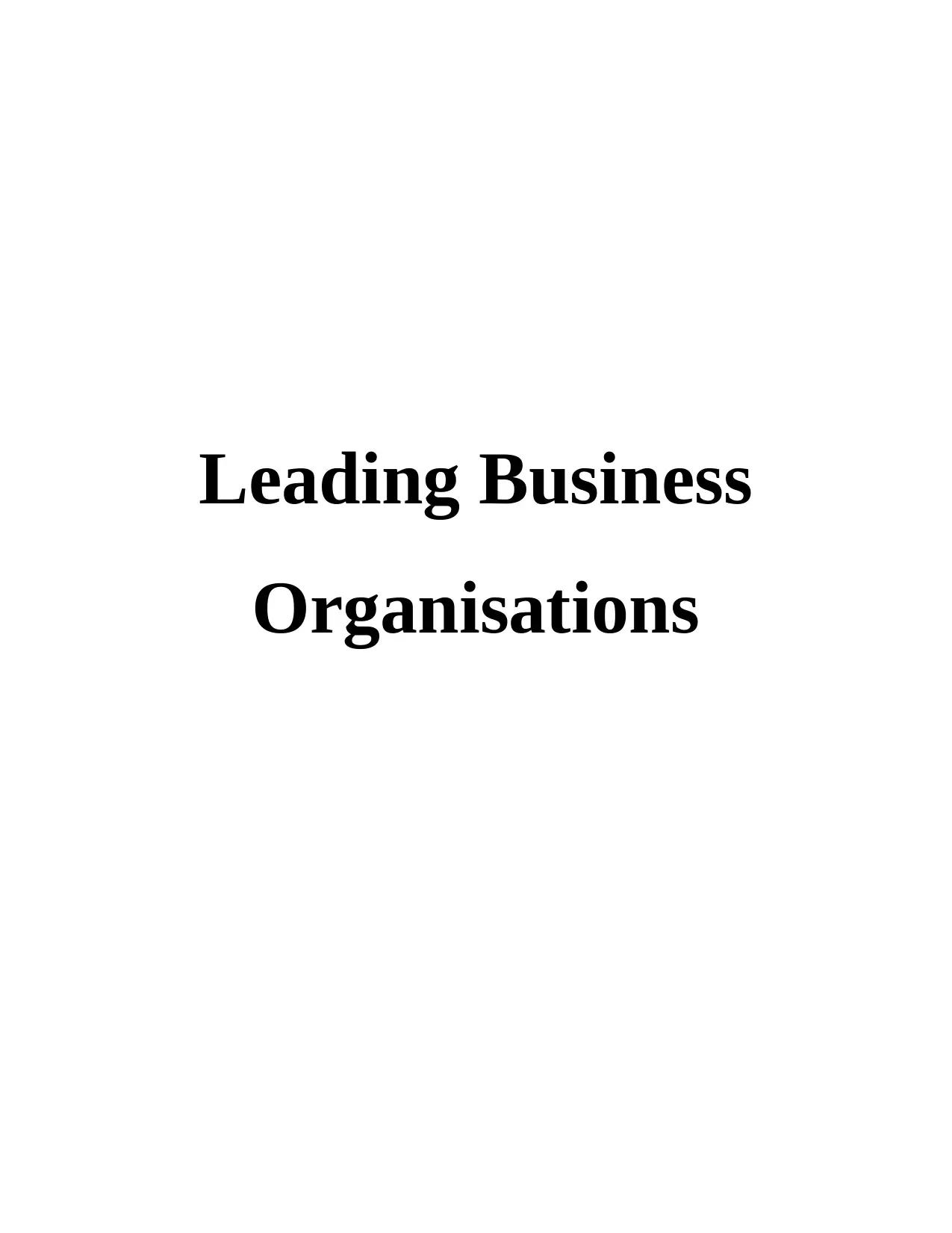
Leading Business
Organisations
Organisations
Paraphrase This Document
Need a fresh take? Get an instant paraphrase of this document with our AI Paraphraser
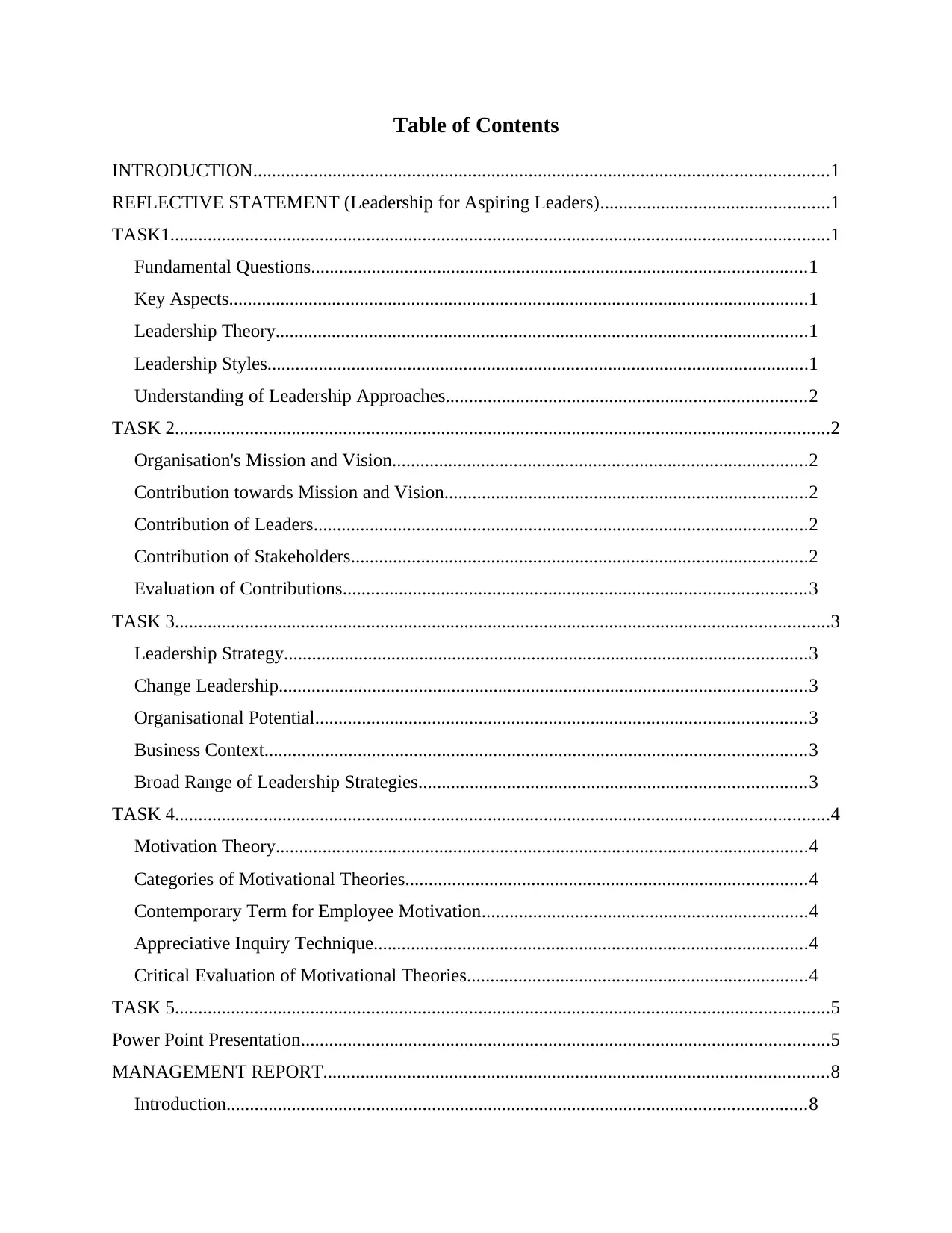
Table of Contents
INTRODUCTION...........................................................................................................................1
REFLECTIVE STATEMENT (Leadership for Aspiring Leaders).................................................1
TASK1.............................................................................................................................................1
Fundamental Questions..........................................................................................................1
Key Aspects............................................................................................................................1
Leadership Theory..................................................................................................................1
Leadership Styles....................................................................................................................1
Understanding of Leadership Approaches.............................................................................2
TASK 2............................................................................................................................................2
Organisation's Mission and Vision.........................................................................................2
Contribution towards Mission and Vision..............................................................................2
Contribution of Leaders..........................................................................................................2
Contribution of Stakeholders..................................................................................................2
Evaluation of Contributions...................................................................................................3
TASK 3............................................................................................................................................3
Leadership Strategy................................................................................................................3
Change Leadership.................................................................................................................3
Organisational Potential.........................................................................................................3
Business Context....................................................................................................................3
Broad Range of Leadership Strategies...................................................................................3
TASK 4............................................................................................................................................4
Motivation Theory..................................................................................................................4
Categories of Motivational Theories......................................................................................4
Contemporary Term for Employee Motivation......................................................................4
Appreciative Inquiry Technique.............................................................................................4
Critical Evaluation of Motivational Theories.........................................................................4
TASK 5............................................................................................................................................5
Power Point Presentation.................................................................................................................5
MANAGEMENT REPORT............................................................................................................8
Introduction............................................................................................................................8
INTRODUCTION...........................................................................................................................1
REFLECTIVE STATEMENT (Leadership for Aspiring Leaders).................................................1
TASK1.............................................................................................................................................1
Fundamental Questions..........................................................................................................1
Key Aspects............................................................................................................................1
Leadership Theory..................................................................................................................1
Leadership Styles....................................................................................................................1
Understanding of Leadership Approaches.............................................................................2
TASK 2............................................................................................................................................2
Organisation's Mission and Vision.........................................................................................2
Contribution towards Mission and Vision..............................................................................2
Contribution of Leaders..........................................................................................................2
Contribution of Stakeholders..................................................................................................2
Evaluation of Contributions...................................................................................................3
TASK 3............................................................................................................................................3
Leadership Strategy................................................................................................................3
Change Leadership.................................................................................................................3
Organisational Potential.........................................................................................................3
Business Context....................................................................................................................3
Broad Range of Leadership Strategies...................................................................................3
TASK 4............................................................................................................................................4
Motivation Theory..................................................................................................................4
Categories of Motivational Theories......................................................................................4
Contemporary Term for Employee Motivation......................................................................4
Appreciative Inquiry Technique.............................................................................................4
Critical Evaluation of Motivational Theories.........................................................................4
TASK 5............................................................................................................................................5
Power Point Presentation.................................................................................................................5
MANAGEMENT REPORT............................................................................................................8
Introduction............................................................................................................................8
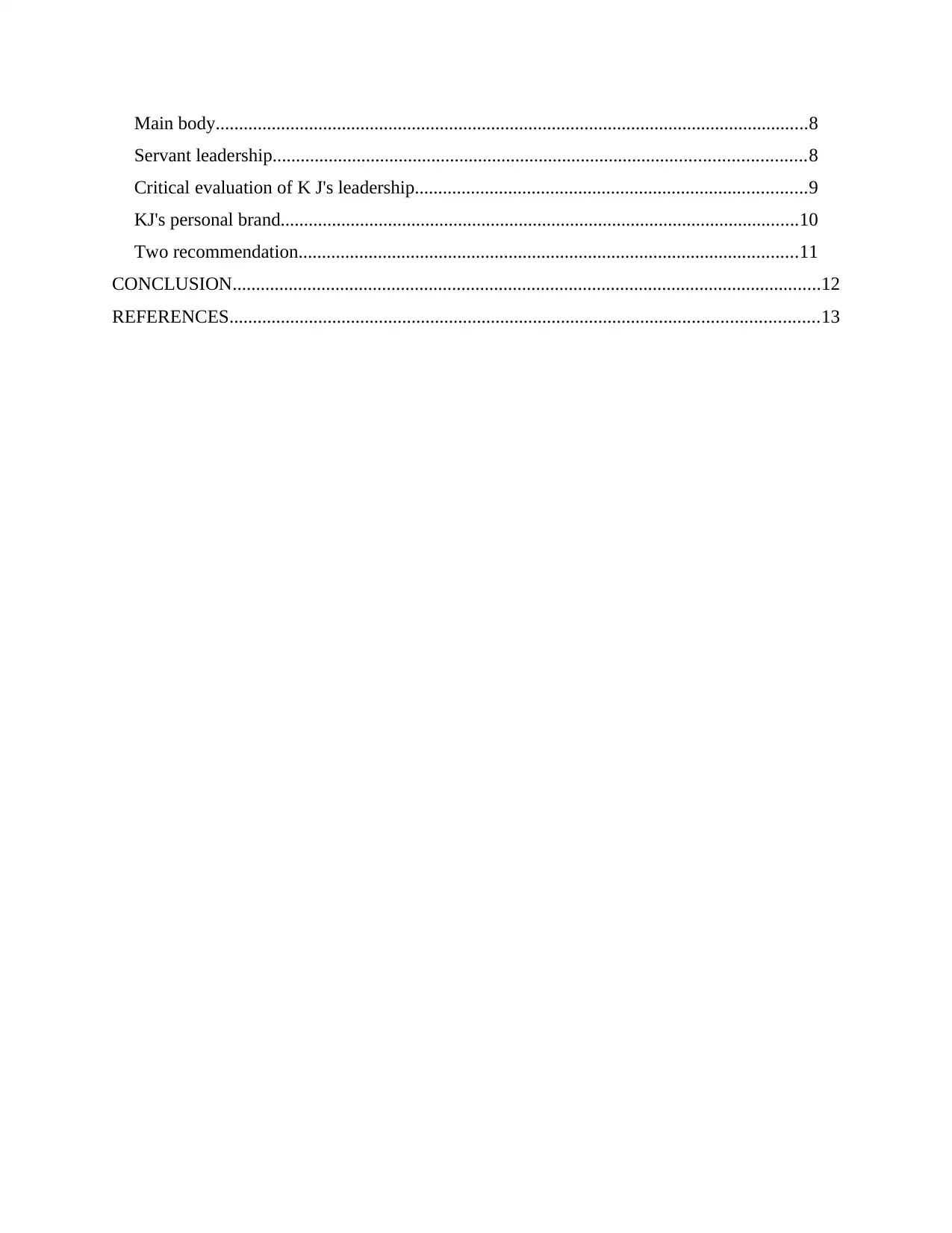
Main body...............................................................................................................................8
Servant leadership..................................................................................................................8
Critical evaluation of K J's leadership....................................................................................9
KJ's personal brand...............................................................................................................10
Two recommendation...........................................................................................................11
CONCLUSION..............................................................................................................................12
REFERENCES..............................................................................................................................13
Servant leadership..................................................................................................................8
Critical evaluation of K J's leadership....................................................................................9
KJ's personal brand...............................................................................................................10
Two recommendation...........................................................................................................11
CONCLUSION..............................................................................................................................12
REFERENCES..............................................................................................................................13
⊘ This is a preview!⊘
Do you want full access?
Subscribe today to unlock all pages.

Trusted by 1+ million students worldwide

Paraphrase This Document
Need a fresh take? Get an instant paraphrase of this document with our AI Paraphraser
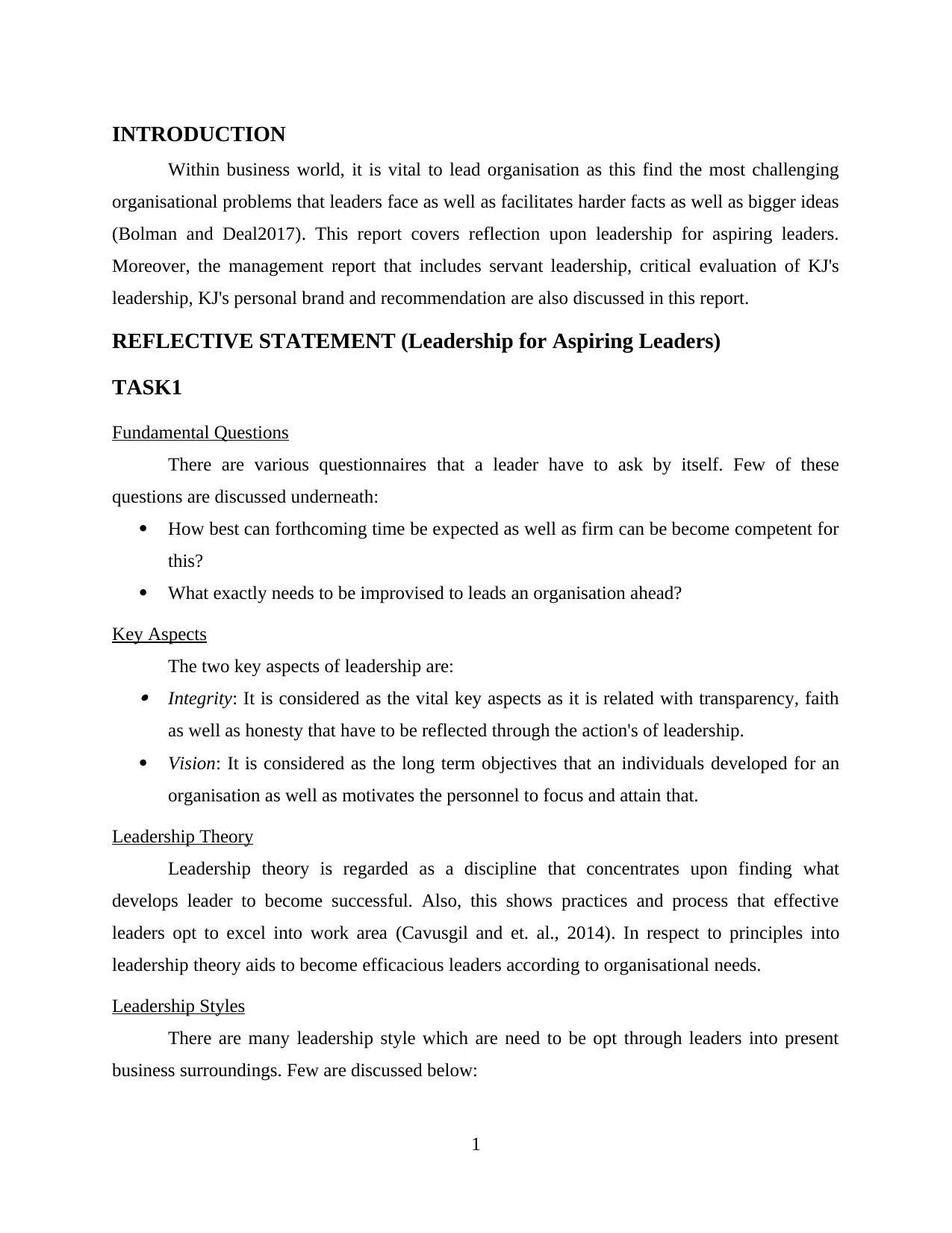
INTRODUCTION
Within business world, it is vital to lead organisation as this find the most challenging
organisational problems that leaders face as well as facilitates harder facts as well as bigger ideas
(Bolman and Deal2017). This report covers reflection upon leadership for aspiring leaders.
Moreover, the management report that includes servant leadership, critical evaluation of KJ's
leadership, KJ's personal brand and recommendation are also discussed in this report.
REFLECTIVE STATEMENT (Leadership for Aspiring Leaders)
TASK1
Fundamental Questions
There are various questionnaires that a leader have to ask by itself. Few of these
questions are discussed underneath:
How best can forthcoming time be expected as well as firm can be become competent for
this?
What exactly needs to be improvised to leads an organisation ahead?
Key Aspects
The two key aspects of leadership are: Integrity: It is considered as the vital key aspects as it is related with transparency, faith
as well as honesty that have to be reflected through the action's of leadership.
Vision: It is considered as the long term objectives that an individuals developed for an
organisation as well as motivates the personnel to focus and attain that.
Leadership Theory
Leadership theory is regarded as a discipline that concentrates upon finding what
develops leader to become successful. Also, this shows practices and process that effective
leaders opt to excel into work area (Cavusgil and et. al., 2014). In respect to principles into
leadership theory aids to become efficacious leaders according to organisational needs.
Leadership Styles
There are many leadership style which are need to be opt through leaders into present
business surroundings. Few are discussed below:
1
Within business world, it is vital to lead organisation as this find the most challenging
organisational problems that leaders face as well as facilitates harder facts as well as bigger ideas
(Bolman and Deal2017). This report covers reflection upon leadership for aspiring leaders.
Moreover, the management report that includes servant leadership, critical evaluation of KJ's
leadership, KJ's personal brand and recommendation are also discussed in this report.
REFLECTIVE STATEMENT (Leadership for Aspiring Leaders)
TASK1
Fundamental Questions
There are various questionnaires that a leader have to ask by itself. Few of these
questions are discussed underneath:
How best can forthcoming time be expected as well as firm can be become competent for
this?
What exactly needs to be improvised to leads an organisation ahead?
Key Aspects
The two key aspects of leadership are: Integrity: It is considered as the vital key aspects as it is related with transparency, faith
as well as honesty that have to be reflected through the action's of leadership.
Vision: It is considered as the long term objectives that an individuals developed for an
organisation as well as motivates the personnel to focus and attain that.
Leadership Theory
Leadership theory is regarded as a discipline that concentrates upon finding what
develops leader to become successful. Also, this shows practices and process that effective
leaders opt to excel into work area (Cavusgil and et. al., 2014). In respect to principles into
leadership theory aids to become efficacious leaders according to organisational needs.
Leadership Styles
There are many leadership style which are need to be opt through leaders into present
business surroundings. Few are discussed below:
1
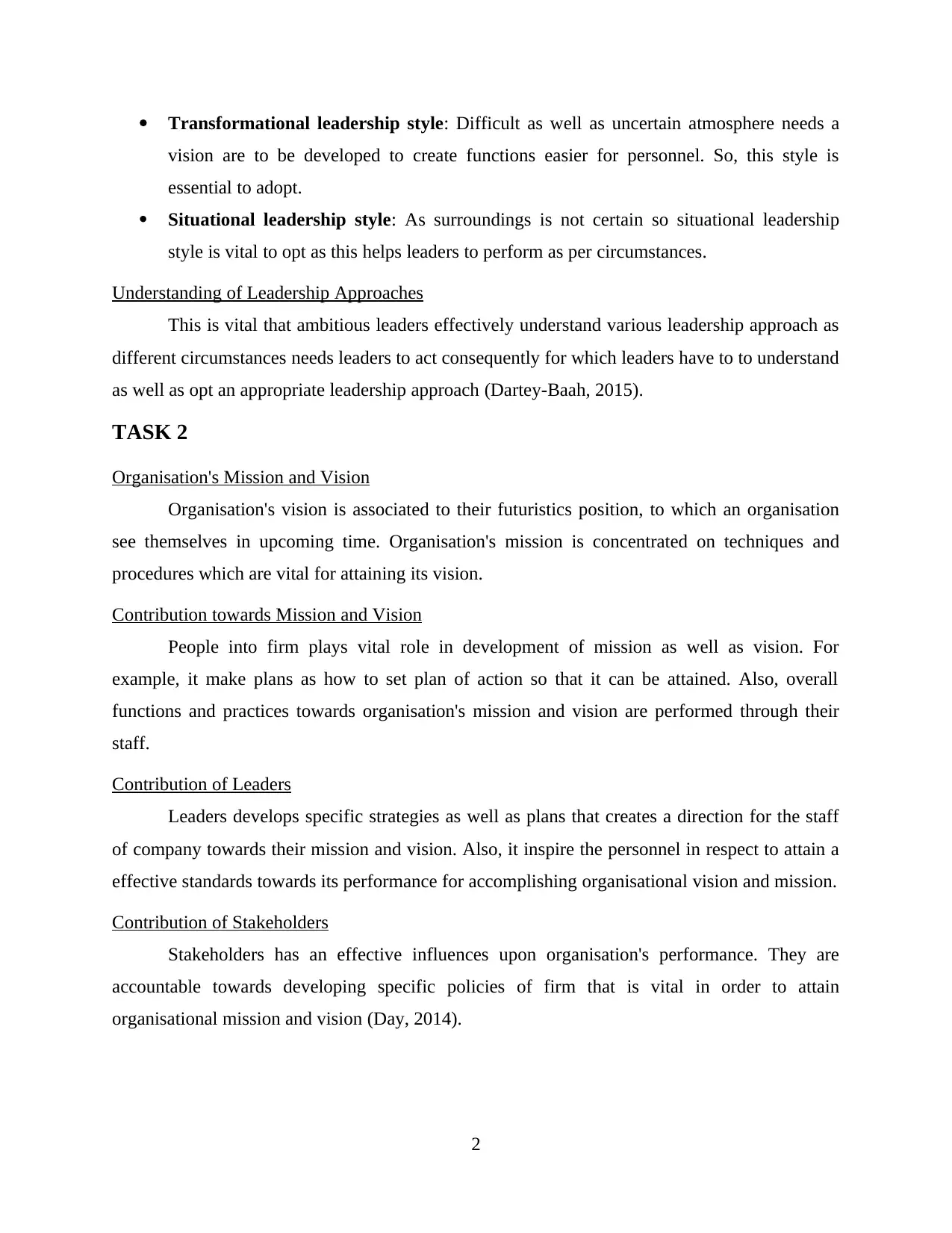
Transformational leadership style: Difficult as well as uncertain atmosphere needs a
vision are to be developed to create functions easier for personnel. So, this style is
essential to adopt.
Situational leadership style: As surroundings is not certain so situational leadership
style is vital to opt as this helps leaders to perform as per circumstances.
Understanding of Leadership Approaches
This is vital that ambitious leaders effectively understand various leadership approach as
different circumstances needs leaders to act consequently for which leaders have to to understand
as well as opt an appropriate leadership approach (Dartey-Baah, 2015).
TASK 2
Organisation's Mission and Vision
Organisation's vision is associated to their futuristics position, to which an organisation
see themselves in upcoming time. Organisation's mission is concentrated on techniques and
procedures which are vital for attaining its vision.
Contribution towards Mission and Vision
People into firm plays vital role in development of mission as well as vision. For
example, it make plans as how to set plan of action so that it can be attained. Also, overall
functions and practices towards organisation's mission and vision are performed through their
staff.
Contribution of Leaders
Leaders develops specific strategies as well as plans that creates a direction for the staff
of company towards their mission and vision. Also, it inspire the personnel in respect to attain a
effective standards towards its performance for accomplishing organisational vision and mission.
Contribution of Stakeholders
Stakeholders has an effective influences upon organisation's performance. They are
accountable towards developing specific policies of firm that is vital in order to attain
organisational mission and vision (Day, 2014).
2
vision are to be developed to create functions easier for personnel. So, this style is
essential to adopt.
Situational leadership style: As surroundings is not certain so situational leadership
style is vital to opt as this helps leaders to perform as per circumstances.
Understanding of Leadership Approaches
This is vital that ambitious leaders effectively understand various leadership approach as
different circumstances needs leaders to act consequently for which leaders have to to understand
as well as opt an appropriate leadership approach (Dartey-Baah, 2015).
TASK 2
Organisation's Mission and Vision
Organisation's vision is associated to their futuristics position, to which an organisation
see themselves in upcoming time. Organisation's mission is concentrated on techniques and
procedures which are vital for attaining its vision.
Contribution towards Mission and Vision
People into firm plays vital role in development of mission as well as vision. For
example, it make plans as how to set plan of action so that it can be attained. Also, overall
functions and practices towards organisation's mission and vision are performed through their
staff.
Contribution of Leaders
Leaders develops specific strategies as well as plans that creates a direction for the staff
of company towards their mission and vision. Also, it inspire the personnel in respect to attain a
effective standards towards its performance for accomplishing organisational vision and mission.
Contribution of Stakeholders
Stakeholders has an effective influences upon organisation's performance. They are
accountable towards developing specific policies of firm that is vital in order to attain
organisational mission and vision (Day, 2014).
2
⊘ This is a preview!⊘
Do you want full access?
Subscribe today to unlock all pages.

Trusted by 1+ million students worldwide
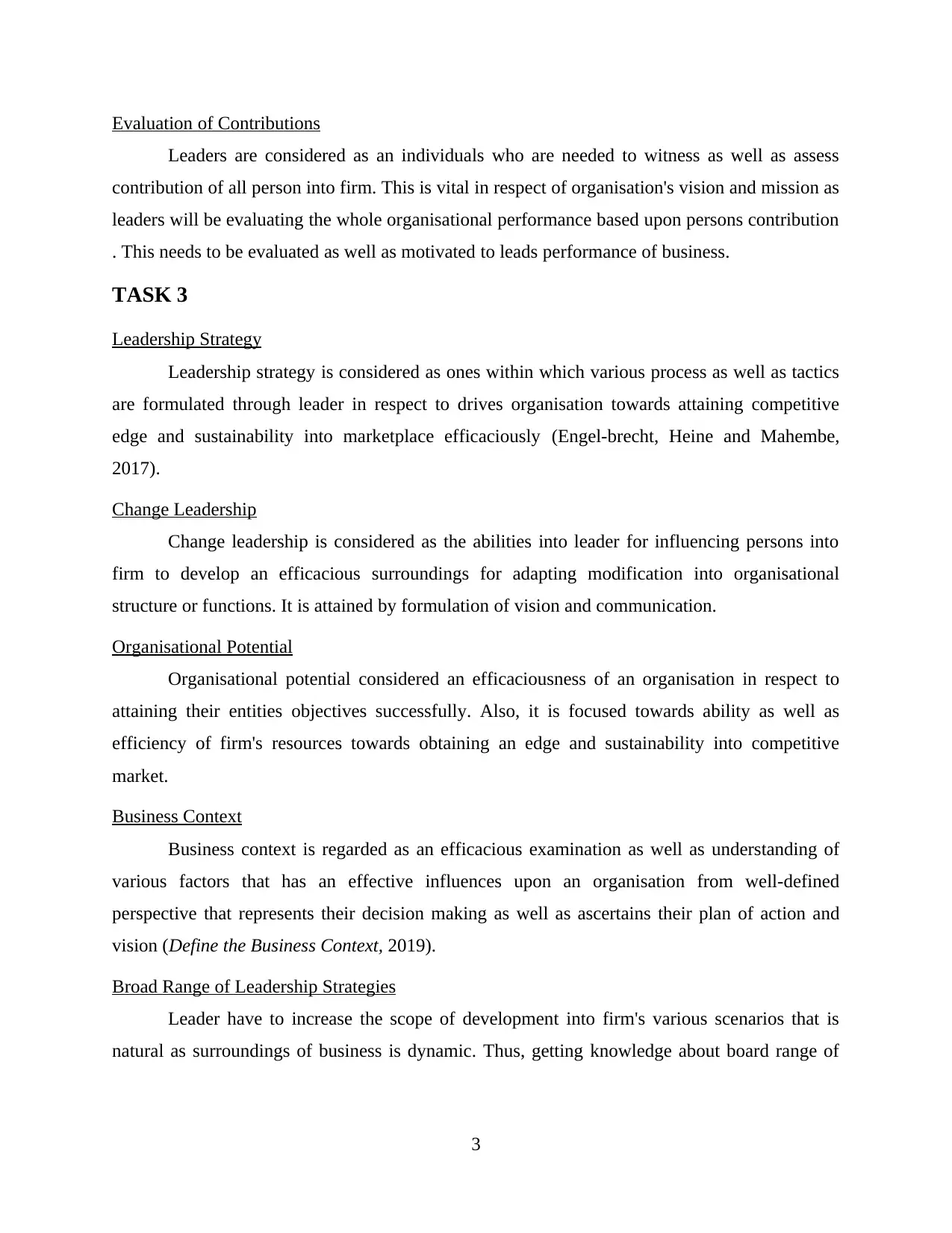
Evaluation of Contributions
Leaders are considered as an individuals who are needed to witness as well as assess
contribution of all person into firm. This is vital in respect of organisation's vision and mission as
leaders will be evaluating the whole organisational performance based upon persons contribution
. This needs to be evaluated as well as motivated to leads performance of business.
TASK 3
Leadership Strategy
Leadership strategy is considered as ones within which various process as well as tactics
are formulated through leader in respect to drives organisation towards attaining competitive
edge and sustainability into marketplace efficaciously (Engel-brecht, Heine and Mahembe,
2017).
Change Leadership
Change leadership is considered as the abilities into leader for influencing persons into
firm to develop an efficacious surroundings for adapting modification into organisational
structure or functions. It is attained by formulation of vision and communication.
Organisational Potential
Organisational potential considered an efficaciousness of an organisation in respect to
attaining their entities objectives successfully. Also, it is focused towards ability as well as
efficiency of firm's resources towards obtaining an edge and sustainability into competitive
market.
Business Context
Business context is regarded as an efficacious examination as well as understanding of
various factors that has an effective influences upon an organisation from well-defined
perspective that represents their decision making as well as ascertains their plan of action and
vision (Define the Business Context, 2019).
Broad Range of Leadership Strategies
Leader have to increase the scope of development into firm's various scenarios that is
natural as surroundings of business is dynamic. Thus, getting knowledge about board range of
3
Leaders are considered as an individuals who are needed to witness as well as assess
contribution of all person into firm. This is vital in respect of organisation's vision and mission as
leaders will be evaluating the whole organisational performance based upon persons contribution
. This needs to be evaluated as well as motivated to leads performance of business.
TASK 3
Leadership Strategy
Leadership strategy is considered as ones within which various process as well as tactics
are formulated through leader in respect to drives organisation towards attaining competitive
edge and sustainability into marketplace efficaciously (Engel-brecht, Heine and Mahembe,
2017).
Change Leadership
Change leadership is considered as the abilities into leader for influencing persons into
firm to develop an efficacious surroundings for adapting modification into organisational
structure or functions. It is attained by formulation of vision and communication.
Organisational Potential
Organisational potential considered an efficaciousness of an organisation in respect to
attaining their entities objectives successfully. Also, it is focused towards ability as well as
efficiency of firm's resources towards obtaining an edge and sustainability into competitive
market.
Business Context
Business context is regarded as an efficacious examination as well as understanding of
various factors that has an effective influences upon an organisation from well-defined
perspective that represents their decision making as well as ascertains their plan of action and
vision (Define the Business Context, 2019).
Broad Range of Leadership Strategies
Leader have to increase the scope of development into firm's various scenarios that is
natural as surroundings of business is dynamic. Thus, getting knowledge about board range of
3
Paraphrase This Document
Need a fresh take? Get an instant paraphrase of this document with our AI Paraphraser
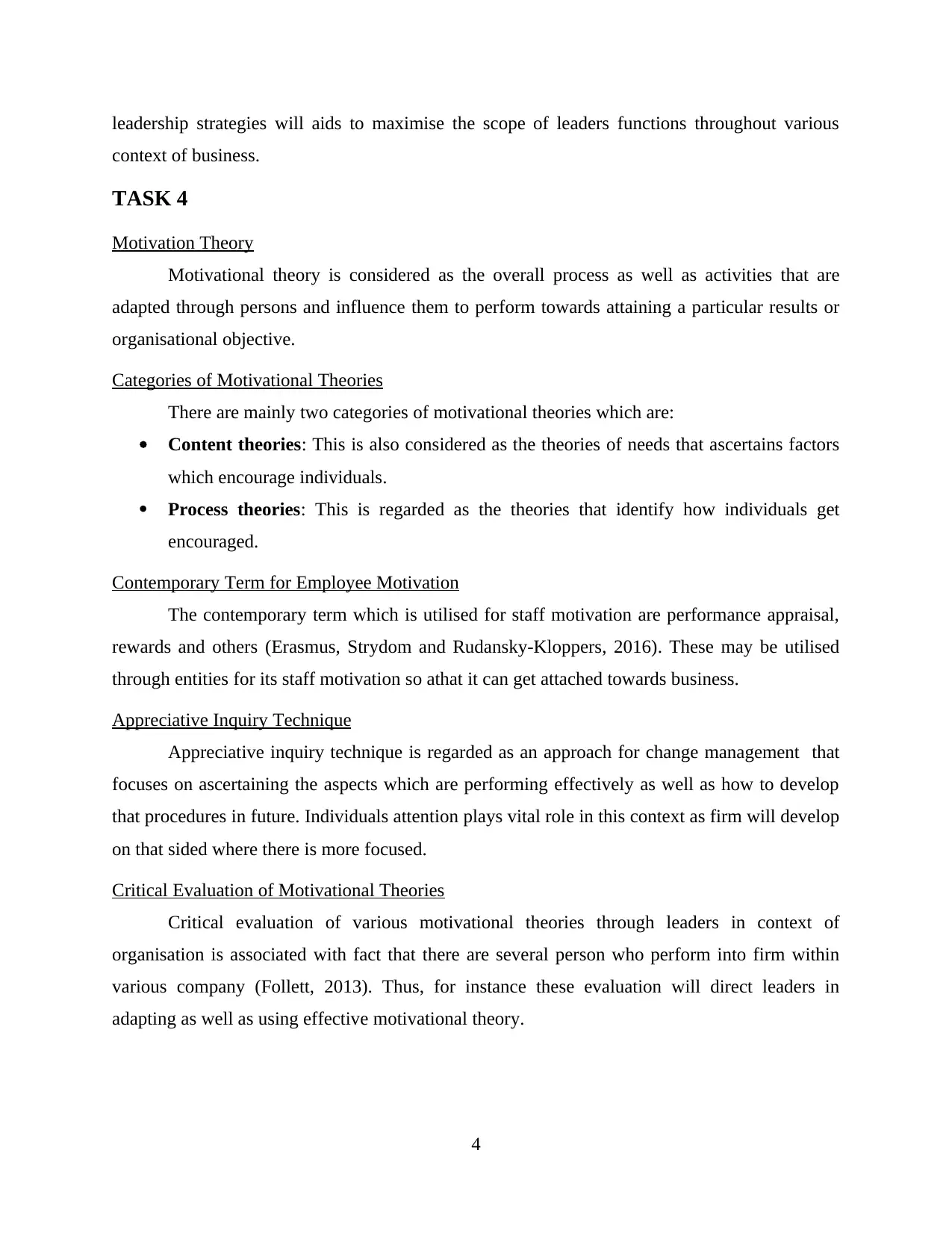
leadership strategies will aids to maximise the scope of leaders functions throughout various
context of business.
TASK 4
Motivation Theory
Motivational theory is considered as the overall process as well as activities that are
adapted through persons and influence them to perform towards attaining a particular results or
organisational objective.
Categories of Motivational Theories
There are mainly two categories of motivational theories which are:
Content theories: This is also considered as the theories of needs that ascertains factors
which encourage individuals.
Process theories: This is regarded as the theories that identify how individuals get
encouraged.
Contemporary Term for Employee Motivation
The contemporary term which is utilised for staff motivation are performance appraisal,
rewards and others (Erasmus, Strydom and Rudansky-Kloppers, 2016). These may be utilised
through entities for its staff motivation so athat it can get attached towards business.
Appreciative Inquiry Technique
Appreciative inquiry technique is regarded as an approach for change management that
focuses on ascertaining the aspects which are performing effectively as well as how to develop
that procedures in future. Individuals attention plays vital role in this context as firm will develop
on that sided where there is more focused.
Critical Evaluation of Motivational Theories
Critical evaluation of various motivational theories through leaders in context of
organisation is associated with fact that there are several person who perform into firm within
various company (Follett, 2013). Thus, for instance these evaluation will direct leaders in
adapting as well as using effective motivational theory.
4
context of business.
TASK 4
Motivation Theory
Motivational theory is considered as the overall process as well as activities that are
adapted through persons and influence them to perform towards attaining a particular results or
organisational objective.
Categories of Motivational Theories
There are mainly two categories of motivational theories which are:
Content theories: This is also considered as the theories of needs that ascertains factors
which encourage individuals.
Process theories: This is regarded as the theories that identify how individuals get
encouraged.
Contemporary Term for Employee Motivation
The contemporary term which is utilised for staff motivation are performance appraisal,
rewards and others (Erasmus, Strydom and Rudansky-Kloppers, 2016). These may be utilised
through entities for its staff motivation so athat it can get attached towards business.
Appreciative Inquiry Technique
Appreciative inquiry technique is regarded as an approach for change management that
focuses on ascertaining the aspects which are performing effectively as well as how to develop
that procedures in future. Individuals attention plays vital role in this context as firm will develop
on that sided where there is more focused.
Critical Evaluation of Motivational Theories
Critical evaluation of various motivational theories through leaders in context of
organisation is associated with fact that there are several person who perform into firm within
various company (Follett, 2013). Thus, for instance these evaluation will direct leaders in
adapting as well as using effective motivational theory.
4
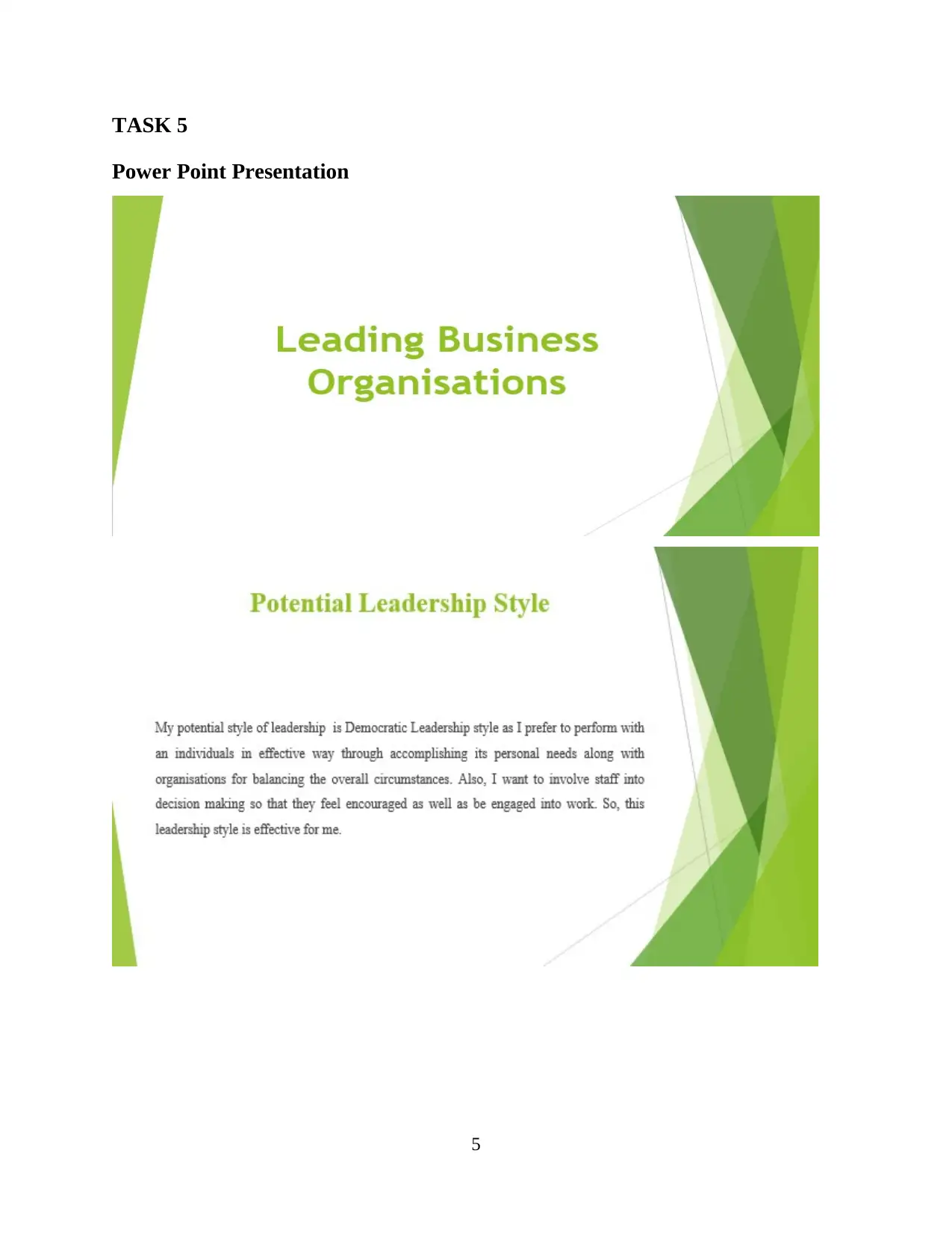
TASK 5
Power Point Presentation
5
Power Point Presentation
5
⊘ This is a preview!⊘
Do you want full access?
Subscribe today to unlock all pages.

Trusted by 1+ million students worldwide
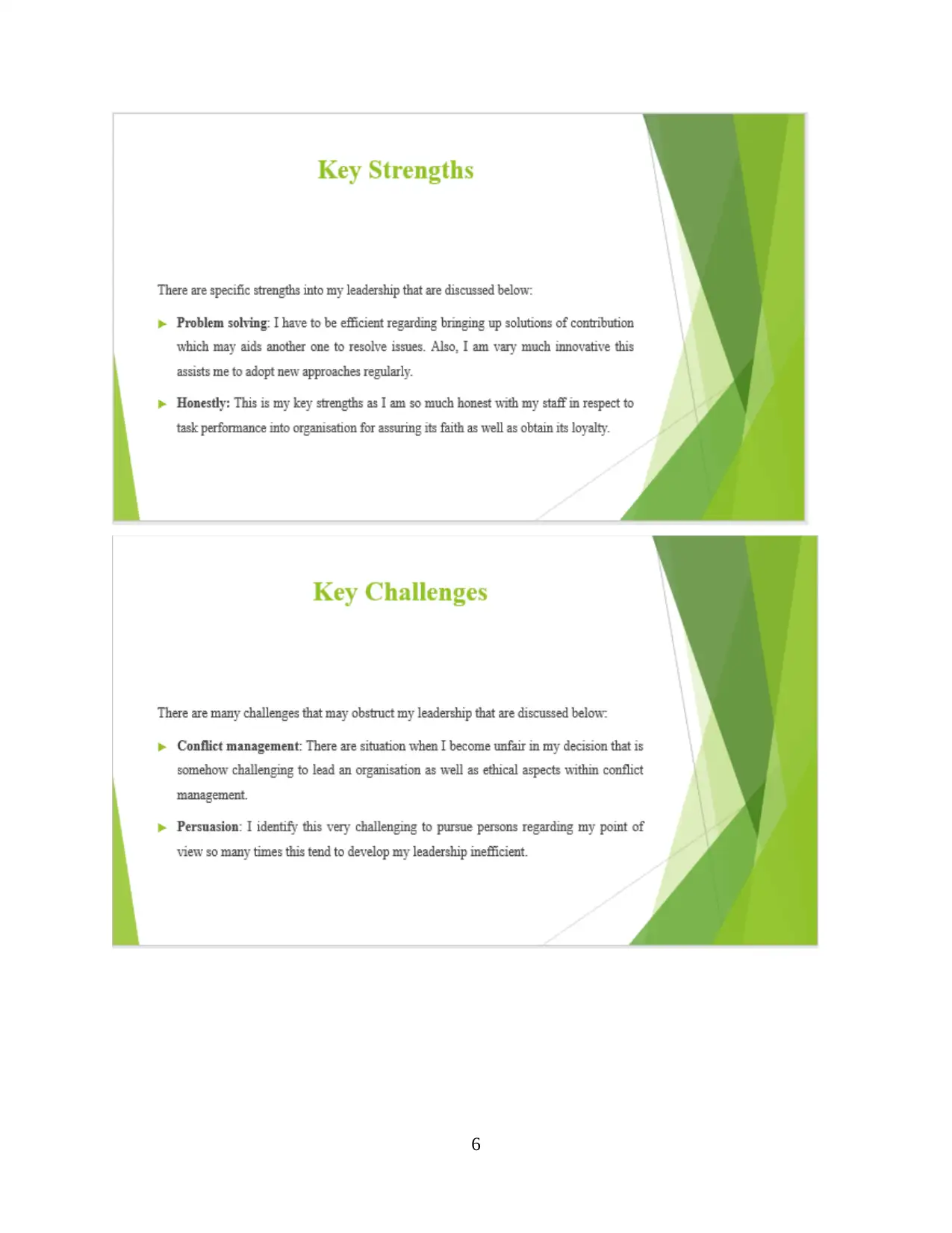
6
Paraphrase This Document
Need a fresh take? Get an instant paraphrase of this document with our AI Paraphraser
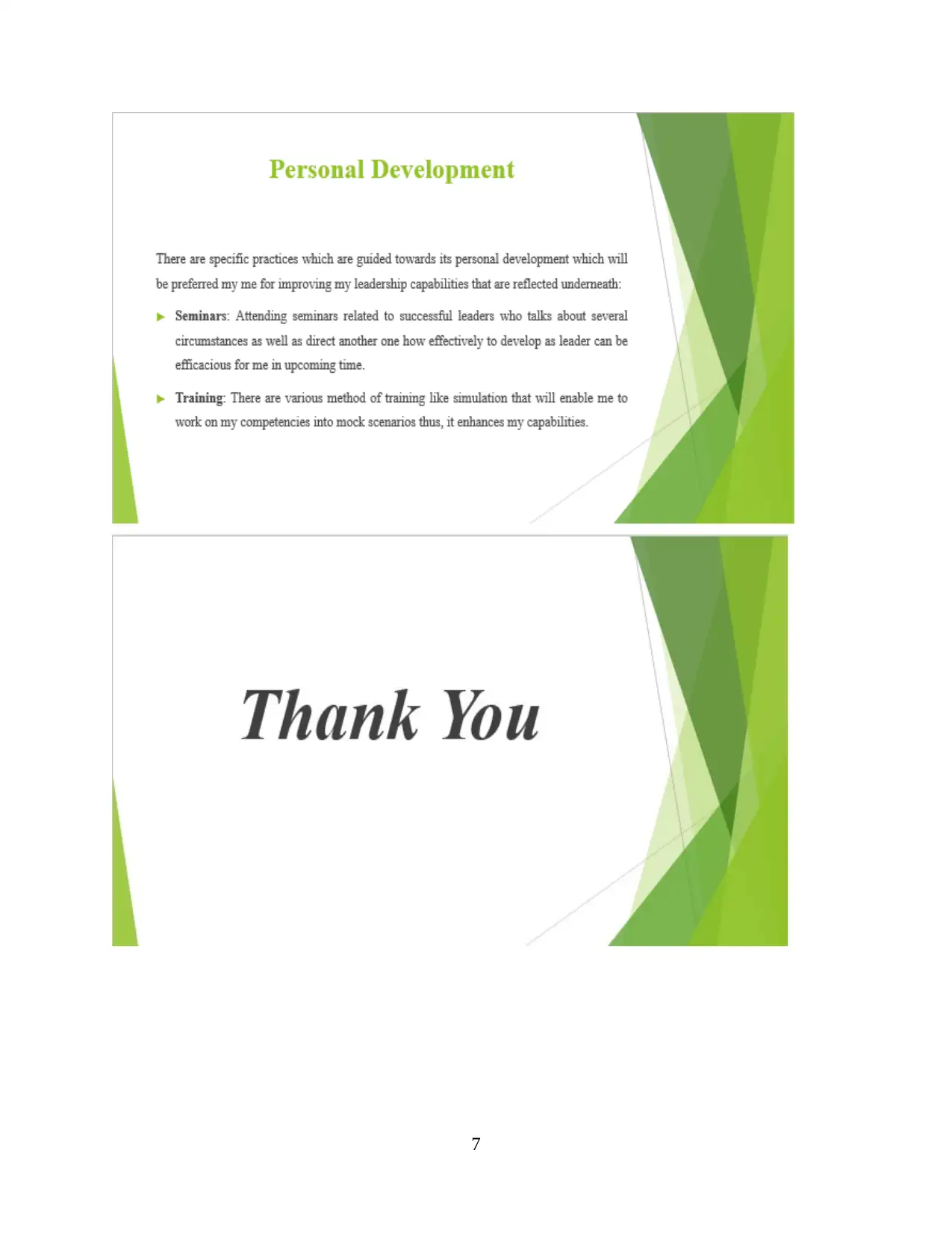
7
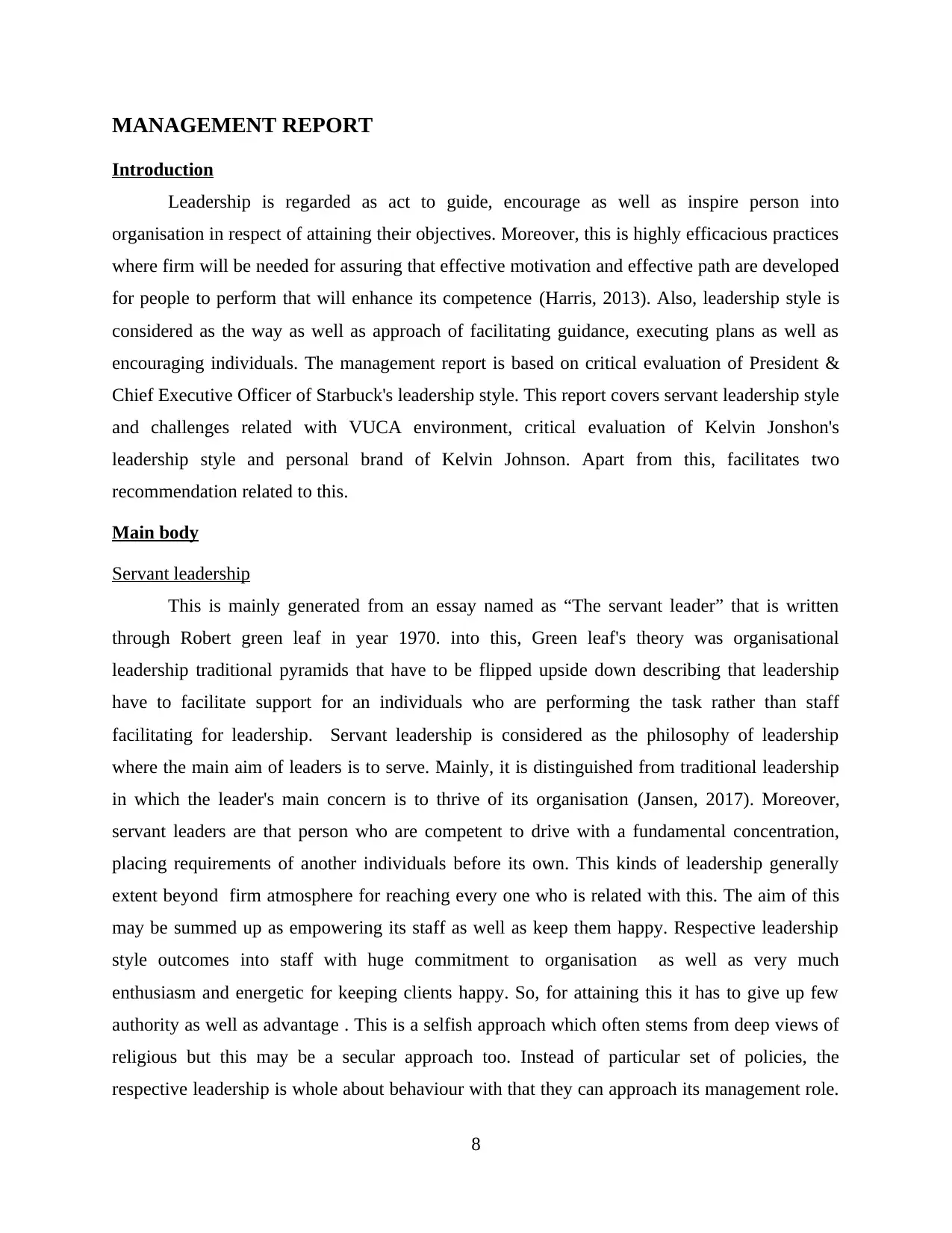
MANAGEMENT REPORT
Introduction
Leadership is regarded as act to guide, encourage as well as inspire person into
organisation in respect of attaining their objectives. Moreover, this is highly efficacious practices
where firm will be needed for assuring that effective motivation and effective path are developed
for people to perform that will enhance its competence (Harris, 2013). Also, leadership style is
considered as the way as well as approach of facilitating guidance, executing plans as well as
encouraging individuals. The management report is based on critical evaluation of President &
Chief Executive Officer of Starbuck's leadership style. This report covers servant leadership style
and challenges related with VUCA environment, critical evaluation of Kelvin Jonshon's
leadership style and personal brand of Kelvin Johnson. Apart from this, facilitates two
recommendation related to this.
Main body
Servant leadership
This is mainly generated from an essay named as “The servant leader” that is written
through Robert green leaf in year 1970. into this, Green leaf's theory was organisational
leadership traditional pyramids that have to be flipped upside down describing that leadership
have to facilitate support for an individuals who are performing the task rather than staff
facilitating for leadership. Servant leadership is considered as the philosophy of leadership
where the main aim of leaders is to serve. Mainly, it is distinguished from traditional leadership
in which the leader's main concern is to thrive of its organisation (Jansen, 2017). Moreover,
servant leaders are that person who are competent to drive with a fundamental concentration,
placing requirements of another individuals before its own. This kinds of leadership generally
extent beyond firm atmosphere for reaching every one who is related with this. The aim of this
may be summed up as empowering its staff as well as keep them happy. Respective leadership
style outcomes into staff with huge commitment to organisation as well as very much
enthusiasm and energetic for keeping clients happy. So, for attaining this it has to give up few
authority as well as advantage . This is a selfish approach which often stems from deep views of
religious but this may be a secular approach too. Instead of particular set of policies, the
respective leadership is whole about behaviour with that they can approach its management role.
8
Introduction
Leadership is regarded as act to guide, encourage as well as inspire person into
organisation in respect of attaining their objectives. Moreover, this is highly efficacious practices
where firm will be needed for assuring that effective motivation and effective path are developed
for people to perform that will enhance its competence (Harris, 2013). Also, leadership style is
considered as the way as well as approach of facilitating guidance, executing plans as well as
encouraging individuals. The management report is based on critical evaluation of President &
Chief Executive Officer of Starbuck's leadership style. This report covers servant leadership style
and challenges related with VUCA environment, critical evaluation of Kelvin Jonshon's
leadership style and personal brand of Kelvin Johnson. Apart from this, facilitates two
recommendation related to this.
Main body
Servant leadership
This is mainly generated from an essay named as “The servant leader” that is written
through Robert green leaf in year 1970. into this, Green leaf's theory was organisational
leadership traditional pyramids that have to be flipped upside down describing that leadership
have to facilitate support for an individuals who are performing the task rather than staff
facilitating for leadership. Servant leadership is considered as the philosophy of leadership
where the main aim of leaders is to serve. Mainly, it is distinguished from traditional leadership
in which the leader's main concern is to thrive of its organisation (Jansen, 2017). Moreover,
servant leaders are that person who are competent to drive with a fundamental concentration,
placing requirements of another individuals before its own. This kinds of leadership generally
extent beyond firm atmosphere for reaching every one who is related with this. The aim of this
may be summed up as empowering its staff as well as keep them happy. Respective leadership
style outcomes into staff with huge commitment to organisation as well as very much
enthusiasm and energetic for keeping clients happy. So, for attaining this it has to give up few
authority as well as advantage . This is a selfish approach which often stems from deep views of
religious but this may be a secular approach too. Instead of particular set of policies, the
respective leadership is whole about behaviour with that they can approach its management role.
8
⊘ This is a preview!⊘
Do you want full access?
Subscribe today to unlock all pages.

Trusted by 1+ million students worldwide
1 out of 17
Related Documents
Your All-in-One AI-Powered Toolkit for Academic Success.
+13062052269
info@desklib.com
Available 24*7 on WhatsApp / Email
![[object Object]](/_next/static/media/star-bottom.7253800d.svg)
Unlock your academic potential
Copyright © 2020–2025 A2Z Services. All Rights Reserved. Developed and managed by ZUCOL.





